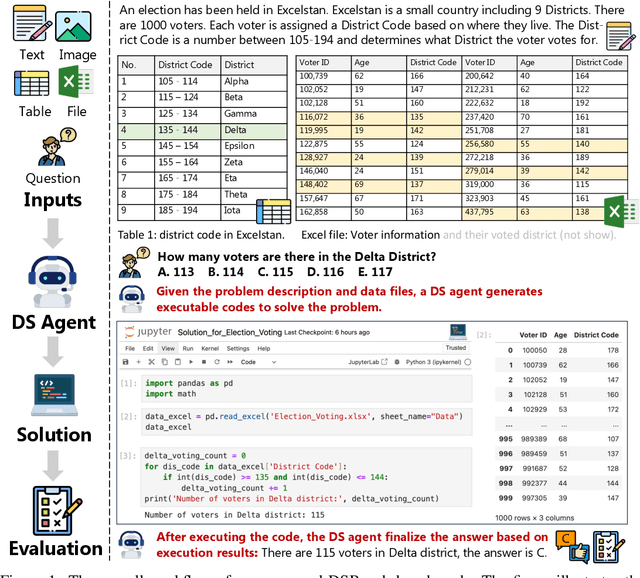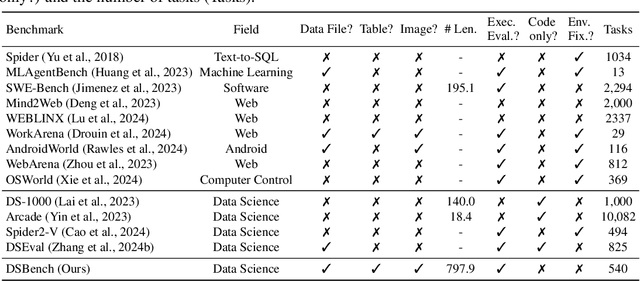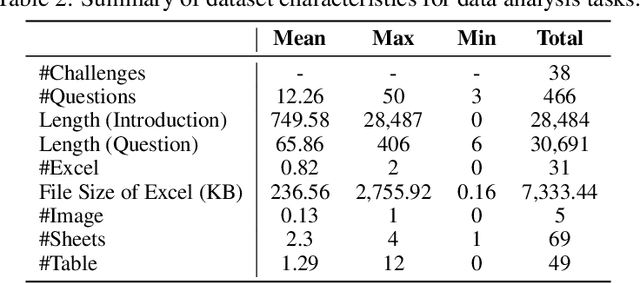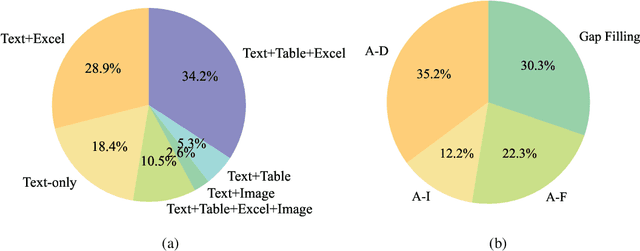Liqiang Jing
FIFA: Unified Faithfulness Evaluation Framework for Text-to-Video and Video-to-Text Generation
Jul 09, 2025Abstract:Video Multimodal Large Language Models (VideoMLLMs) have achieved remarkable progress in both Video-to-Text and Text-to-Video tasks. However, they often suffer fro hallucinations, generating content that contradicts the visual input. Existing evaluation methods are limited to one task (e.g., V2T) and also fail to assess hallucinations in open-ended, free-form responses. To address this gap, we propose FIFA, a unified FaIthFulness evAluation framework that extracts comprehensive descriptive facts, models their semantic dependencies via a Spatio-Temporal Semantic Dependency Graph, and verifies them using VideoQA models. We further introduce Post-Correction, a tool-based correction framework that revises hallucinated content. Extensive experiments demonstrate that FIFA aligns more closely with human judgment than existing evaluation methods, and that Post-Correction effectively improves factual consistency in both text and video generation.
Speech Recognition on TV Series with Video-guided Post-Correction
Jun 08, 2025Abstract:Automatic Speech Recognition (ASR) has achieved remarkable success with deep learning, driving advancements in conversational artificial intelligence, media transcription, and assistive technologies. However, ASR systems still struggle in complex environments such as TV series, where overlapping speech, domain-specific terminology, and long-range contextual dependencies pose significant challenges to transcription accuracy. Existing multimodal approaches fail to correct ASR outputs with the rich temporal and contextual information available in video. To address this limitation, we propose a novel multimodal post-correction framework that refines ASR transcriptions by leveraging contextual cues extracted from video. Our framework consists of two stages: ASR Generation and Video-based Post-Correction, where the first stage produces the initial transcript and the second stage corrects errors using Video-based Contextual Information Extraction and Context-aware ASR Correction. We employ the Video-Large Multimodal Model (VLMM) to extract key contextual information using tailored prompts, which is then integrated with a Large Language Model (LLM) to refine the ASR output. We evaluate our method on a multimodal benchmark for TV series ASR and demonstrate its effectiveness in improving ASR performance by leveraging video-based context to enhance transcription accuracy in complex multimedia environments.
A Comprehensive Analysis for Visual Object Hallucination in Large Vision-Language Models
May 04, 2025Abstract:Large Vision-Language Models (LVLMs) demonstrate remarkable capabilities in multimodal tasks, but visual object hallucination remains a persistent issue. It refers to scenarios where models generate inaccurate visual object-related information based on the query input, potentially leading to misinformation and concerns about safety and reliability. Previous works focus on the evaluation and mitigation of visual hallucinations, but the underlying causes have not been comprehensively investigated. In this paper, we analyze each component of LLaVA-like LVLMs -- the large language model, the vision backbone, and the projector -- to identify potential sources of error and their impact. Based on our observations, we propose methods to mitigate hallucination for each problematic component. Additionally, we developed two hallucination benchmarks: QA-VisualGenome, which emphasizes attribute and relation hallucinations, and QA-FB15k, which focuses on cognition-based hallucinations.
Learning to Generate Research Idea with Dynamic Control
Dec 19, 2024Abstract:The rapid advancements in large language models (LLMs) have demonstrated their potential to accelerate scientific discovery, particularly in automating the process of research ideation. LLM-based systems have shown promise in generating hypotheses and research ideas. However, current approaches predominantly rely on prompting-based pre-trained models, limiting their ability to optimize generated content effectively. Moreover, they also lack the capability to deal with the complex interdependence and inherent restrictions among novelty, feasibility, and effectiveness, which remains challenging due to the inherent trade-offs among these dimensions, such as the innovation-feasibility conflict. To address these limitations, we for the first time propose fine-tuning LLMs to be better idea proposers and introduce a novel framework that employs a two-stage approach combining Supervised Fine-Tuning (SFT) and controllable Reinforcement Learning (RL). In the SFT stage, the model learns foundational patterns from pairs of research papers and follow-up ideas. In the RL stage, multi-dimensional reward modeling, guided by fine-grained feedback, evaluates and optimizes the generated ideas across key metrics. Dimensional controllers enable dynamic adjustment of generation, while a sentence-level decoder ensures context-aware emphasis during inference. Our framework provides a balanced approach to research ideation, achieving high-quality outcomes by dynamically navigating the trade-offs among novelty, feasibility, and effectiveness.
Defeasible Visual Entailment: Benchmark, Evaluator, and Reward-Driven Optimization
Dec 19, 2024Abstract:We introduce a new task called Defeasible Visual Entailment (DVE), where the goal is to allow the modification of the entailment relationship between an image premise and a text hypothesis based on an additional update. While this concept is well-established in Natural Language Inference, it remains unexplored in visual entailment. At a high level, DVE enables models to refine their initial interpretations, leading to improved accuracy and reliability in various applications such as detecting misleading information in images, enhancing visual question answering, and refining decision-making processes in autonomous systems. Existing metrics do not adequately capture the change in the entailment relationship brought by updates. To address this, we propose a novel inference-aware evaluator designed to capture changes in entailment strength induced by updates, using pairwise contrastive learning and categorical information learning. Additionally, we introduce a reward-driven update optimization method to further enhance the quality of updates generated by multimodal models. Experimental results demonstrate the effectiveness of our proposed evaluator and optimization method.
A Unified Hallucination Mitigation Framework for Large Vision-Language Models
Sep 24, 2024



Abstract:Hallucination is a common problem for Large Vision-Language Models (LVLMs) with long generations which is difficult to eradicate. The generation with hallucinations is partially inconsistent with the image content. To mitigate hallucination, current studies either focus on the process of model inference or the results of model generation, but the solutions they design sometimes do not deal appropriately with various types of queries and the hallucinations of the generations about these queries. To accurately deal with various hallucinations, we present a unified framework, Dentist, for hallucination mitigation. The core step is to first classify the queries, then perform different processes of hallucination mitigation based on the classification result, just like a dentist first observes the teeth and then makes a plan. In a simple deployment, Dentist can classify queries as perception or reasoning and easily mitigate potential hallucinations in answers which has been demonstrated in our experiments. On MMbench, we achieve a 13.44%/10.2%/15.8% improvement in accuracy on Image Quality, a Coarse Perception visual question answering (VQA) task, over the baseline InstructBLIP/LLaVA/VisualGLM.
DSBench: How Far Are Data Science Agents to Becoming Data Science Experts?
Sep 12, 2024



Abstract:Large Language Models (LLMs) and Large Vision-Language Models (LVLMs) have demonstrated impressive language/vision reasoning abilities, igniting the recent trend of building agents for targeted applications such as shopping assistants or AI software engineers. Recently, many data science benchmarks have been proposed to investigate their performance in the data science domain. However, existing data science benchmarks still fall short when compared to real-world data science applications due to their simplified settings. To bridge this gap, we introduce DSBench, a comprehensive benchmark designed to evaluate data science agents with realistic tasks. This benchmark includes 466 data analysis tasks and 74 data modeling tasks, sourced from Eloquence and Kaggle competitions. DSBench offers a realistic setting by encompassing long contexts, multimodal task backgrounds, reasoning with large data files and multi-table structures, and performing end-to-end data modeling tasks. Our evaluation of state-of-the-art LLMs, LVLMs, and agents shows that they struggle with most tasks, with the best agent solving only 34.12% of data analysis tasks and achieving a 34.74% Relative Performance Gap (RPG). These findings underscore the need for further advancements in developing more practical, intelligent, and autonomous data science agents.
FGAIF: Aligning Large Vision-Language Models with Fine-grained AI Feedback
Apr 07, 2024Abstract:Large Vision-Language Models (LVLMs) have demonstrated proficiency in tackling a variety of visual-language tasks. However, current LVLMs suffer from misalignment between text and image modalities which causes three kinds of hallucination problems, i.e., object existence, object attribute, and object relationship. To tackle this issue, existing methods mainly utilize Reinforcement Learning (RL) to align modalities in LVLMs. However, they still suffer from three main limitations: (1) General feedback can not indicate the hallucination type contained in the response; (2) Sparse rewards only give the sequence-level reward for the whole response; and (3)Annotation cost is time-consuming and labor-intensive. To handle these limitations, we propose an innovative method to align modalities in LVLMs through Fine-Grained Artificial Intelligence Feedback (FGAIF), which mainly consists of three steps: AI-based Feedback Collection, Fine-grained Reward Model Training, and Reinforcement Learning with Fine-grained Reward. Specifically, We first utilize AI tools to predict the types of hallucination for each segment in the response and obtain a collection of fine-grained feedback. Then, based on the collected reward data, three specialized reward models are trained to produce dense rewards. Finally, a novel fine-grained feedback module is integrated into the Proximal Policy Optimization (PPO) algorithm. Extensive experiments are conducted on hallucination and general benchmarks, demonstrating the superior performance of our proposed method. Notably, compared with previous models trained with the RL-based aligning method, our proposed method is effective even with fewer parameters.
Fine-grained and Explainable Factuality Evaluation for Multimodal Summarization
Feb 18, 2024Abstract:Multimodal summarization aims to generate a concise summary based on the input text and image. However, the existing methods potentially suffer from unfactual output. To evaluate the factuality of multimodal summarization models, we propose two fine-grained and explainable evaluation frameworks (FALLACIOUS) for different application scenarios, i.e. reference-based factuality evaluation framework and reference-free factuality evaluation framework. Notably, the reference-free factuality evaluation framework doesn't need ground truth and hence it has a wider application scenario. To evaluate the effectiveness of the proposed frameworks, we compute the correlation between our frameworks and the other metrics. The experimental results show the effectiveness of our proposed method. We will release our code and dataset via github.
Sentiment-enhanced Graph-based Sarcasm Explanation in Dialogue
Feb 06, 2024Abstract:Sarcasm Explanation in Dialogue (SED) is a new yet challenging task, which aims to generate a natural language explanation for the given sarcastic dialogue that involves multiple modalities (i.e., utterance, video, and audio). Although existing studies have achieved great success based on the generative pretrained language model BART, they overlook exploiting the sentiments residing in the utterance, video and audio, which are vital clues for sarcasm explanation. In fact, it is non-trivial to incorporate sentiments for boosting SED performance, due to three main challenges: 1) diverse effects of utterance tokens on sentiments; 2) gap between video-audio sentiment signals and the embedding space of BART; and 3) various relations among utterances, utterance sentiments, and video-audio sentiments. To tackle these challenges, we propose a novel sEntiment-enhanceD Graph-based multimodal sarcasm Explanation framework, named EDGE. In particular, we first propose a lexicon-guided utterance sentiment inference module, where a heuristic utterance sentiment refinement strategy is devised. We then develop a module named Joint Cross Attention-based Sentiment Inference (JCA-SI) by extending the multimodal sentiment analysis model JCA to derive the joint sentiment label for each video-audio clip. Thereafter, we devise a context-sentiment graph to comprehensively model the semantic relations among the utterances, utterance sentiments, and video-audio sentiments, to facilitate sarcasm explanation generation. Extensive experiments on the publicly released dataset WITS verify the superiority of our model over cutting-edge methods.
 Add to Chrome
Add to Chrome Add to Firefox
Add to Firefox Add to Edge
Add to Edge